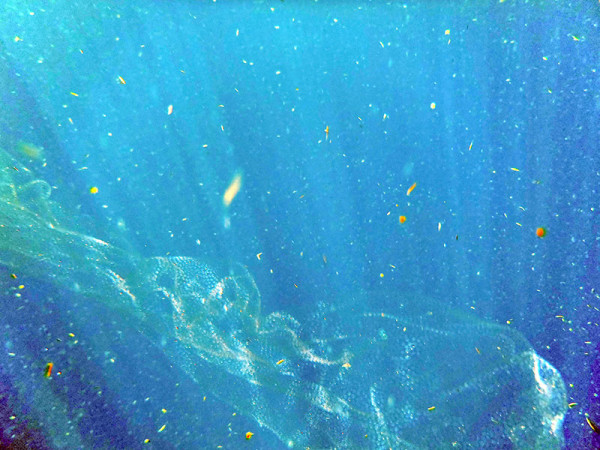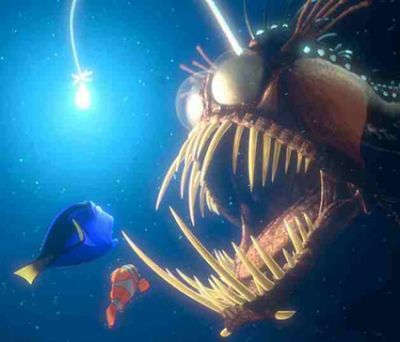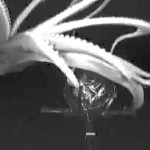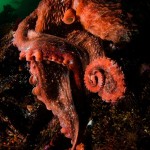We had a bit of a mystery pop up while in Mexico recently for our annual whale shark research project, one with a funky twist and room for a a pretty good sequel. As those of you who’ve followed the work may know (and if you haven’t, you can read about it here), whale sharks come to the Yucatan every summer to feed on fish spawn. Specifically, they’re nom-nomming their way through vast quantities of embryos of the little tunny, Euthynnus alleteratus, a smallish tuna called “bonito” in Mexico (a name that refers to a different small tuna in English speaking countries: Sarda spp.). It’s a spectacular biological event, wondrous to behold, unless you’re a baby tuna, in which case it’s a disaster of holocaust proportions.
While we were tootling around the warm surface waters gathering whale shark photo ID’s, deploying satellite tags and generally having good clean wholesome scientific fun, we noticed that some of the fish eggs were not floating freely but were gathered together in diaphanous sheets. (See what I did there? I could have said see-through or translucent, but I didn’t; I said diaphanous. I’ve always wanted to use the word diaphanous in a blog post; it brings to mind images of soft and dangly arm wattle silhouetted through your grandma’s nightie…) ANYHOO, here’s what they looked like:
In this still shot I cranked the levels a bit so that you could see the eggs arrayed neatly in the jelly matrix:

So what’s the deal here? Are tuna laying eggs in sheets, now? Probably not, no, but with a bit of digging, we found a good theory and have started on a path to the truth.
There’s only one group of fishes that’s known to lay its eggs in sheets like these, and they aren’t tunas. In fact, they’re about as far from tuna as you can get. It’s the anglerfishes, or members of the order Lophiiformes, and the sheets they lay are more properly called “egg veils” (another diaphanous fabric, although usually obscuring something a little younger and less wrinkly than does nanna’s nightie). Familiar anglers include the goosefish, a table favourite in the northeast sold as monkfish, and the (only slightly) more hideous deep sea anglers such as the one featured in that N-word movie:

The thing is, we were in tropical Mexico, at the surface, in 150ft of clear pelagic water. Ain’t no anglers here, right? Not so fast! There IS a tropical pelagic anglerfish, and here it is:

It’s the sargassum fish, Histrio histrio, a small relative of the anglerfish that lives its whole life camouflaged among the rafts of floating sargassum seaweed that form rich little islands of diversity floating in the warm, still plegaic zones of the world. At just a few inches long, it’s not a big fish, but big enough to make the egg veils we were seeing and a very likely candidate given the abundance of sargassum in the area; the tuna eggs are not the only things pushed together by breezes and offshore currents.
So there’s a good hypothesis to solve the mystery of the, ahem, diaphanous egg sheets. The sequel to this story will be the confirmation (or not) of this idea by DNA analysis. For that, our Mexican colleague Rafael de la Parra will use the lab at ECOSUR, and we’ll send some matching samples to the Smithsonian’s Lab for Analytical Biology in DC, and both labs will do some DNA barcoding. Regardless of the outcome, the important thing is that something that seemed simple – tuna spawn, whale sharks eat spawn, end of story – turns out to have hidden diversity and a surprising twist of biological complexity. And I love the fact that you can only make these sorts of discoveries by getting out there, getting wet, and sticking your face in the water. It might not be high tech, but to me it’s science at its simplest and purest.






I had Histrio release such masses in a tank in college (80’s). There is another (new) fish that releases eggs in mucous… lion fish. Not sure if there had been good work on ID / images of P. volitans egg masses. I understand that these are typical of lophiiforms , but could they be from lion fish(?) They release up to 2,000,000 eggs a year (10 times that of a palmetto cockroach to give you reference), and do so every few days (according to current documentation).
Ya know, diaphanous can also have some pretty alluring uses. I always think of diaphanous in reference to the scant “coverings” artists paint on graces or muses. They are *always* diaphanous. i.e.:
Raphael, Rubens, and Botticelli (painter also of the scantily-clad (and nautically-themed) “Dame in Clam” (AKA “The Birth of Venus”).
Ooooh, well they certainly have tons of them in that part of Mexico. Perhaps they’re lionfish. The DNA will tell, thanks for the tip!
I just got an idea for Lady Gaga’s next MTV Music Video Awards outfit…
That’s very cool – I’ve seen similar veils offshore in the GOM drift by the anchor line while sitting at decompression stops and always assumed them to be Histrio rafts (as this was years ago- at that time Pterois had yet to be sighted in Belize or the Yucatan and certainly had not made to the Texas coast yet.
I’ve tried my hand at raising the eggs several times as well – was able to estimate the fecundity based on samples of egg veils at about 150-425k eggs per spawning event (and it has always fascinated me how a 10cm fish can produce up to a meter long veil of mucous!)
I was actually able to get shots of development a few years ago, i find that the eggs start to become visible at about 120-140 hours after fertilization, here’s a shot of what the spots you digitally enhanced to show to the readers probably looked like microscopically (if they are indeed Histro and not Pterois): http://fishbase.us/Photos/PicturesSummary.php?StartRow=0&ID=3089&what=larvegg&TotRec=3
…also the other commenter is definitely on to something – if you haven’t already check out the google art project- they have ultra high res photos of that “dame in clam” painting that let you zoom in enough to see the brushstrokes!
That’s terrific; did you ever get them to a point where you could say they were sargassum fish? I’ve looked at the lionfish egg masses and those are similar, but without the opportunity to raise them, we’re going to have to rely on DNA to tell us what we’re dealing with. Wouldn’t it be cool if it turned out to be BOTH?
and THIS is an example of why I keep coming back to this blog! The collaborative efforts, the sharing of knowledge, and the collective sense of wonder.
And comments like yours are what keep us going – thanks!
Of course you have to be careful, collecting wayward egg cases… remember “Surface”? ;)
Did I mention that I am using sea salps and giant siphonophores as the basis for a beastie in my Sunday D&D game? Envision a collective mass of gelatinous human heads collected from the recently deceased.
This is SO AWESOME! Thanks for sharing the discovery! I am wondering, since I am an invertebrate lover, at what point you became sure that the eggs belonged to a fish? And also, because I am an embryology fan, how far along in development were they? Could you have collected some and tried to hatch them out in an aquarium?
(I’ve also had the good fortune of stumbling across an unexpected egg mass in the middle of the ocean–it was pretty much the highlight of grad school!)
I’m beginning to think that DSN needs an IRC channel and a weekly chat, to share this enthusiasm in real-time. :)
No, unfortunately never got them much further than this point- the egg rafts seem vary much susceptible to protozoa that decompose the gelatinous matrix
…I’ve always wondered if the egg masses derive some protection from the sargassum they are normally associated with- there is some literature describing antimicrobial compounds produced by sargassum – and while it certianly supports a huge ecosystem unto itself I’ve never seen much growing directly on live sargassum as with other flotsam and jetsam from the GOM; only bryozoans, never any barnacles, polychaetes, and rarely even epiphytic algae.
…keep us posted on what these turn out to be! great post!